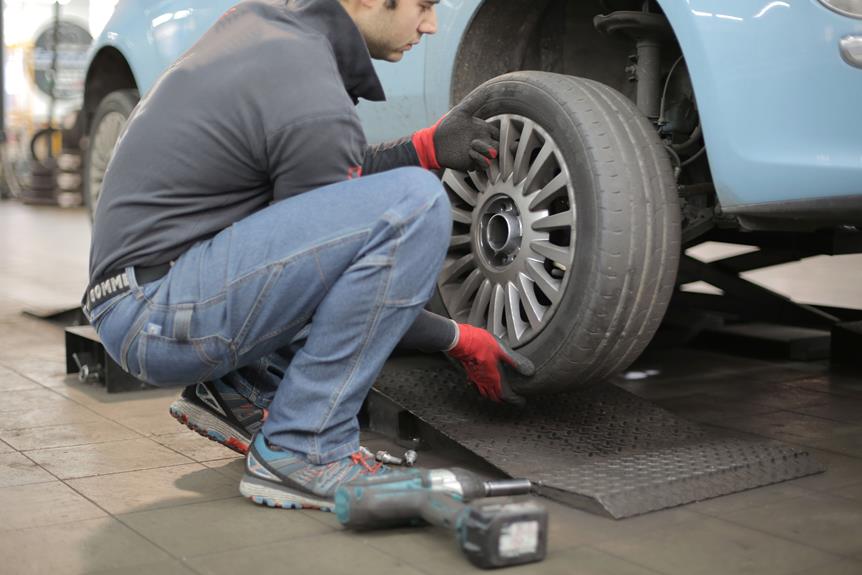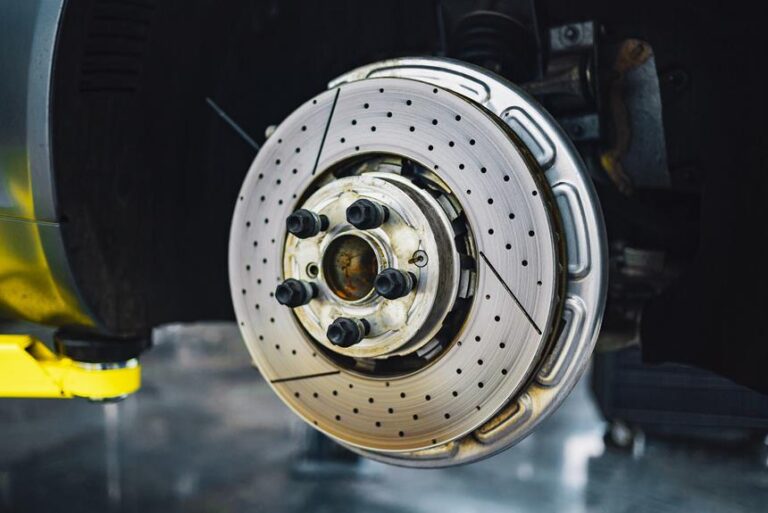Quick Tire Repairs With Repair Kits
Are you tired of the inconvenience and cost of frequent tire repairs? Look no further than tire repair kits.
Despite their compact size, these kits can be a game-changer when it comes to quick and efficient tire repairs.
In this article, we will delve into the benefits of tire repair kits, how they work, and the essential tools needed for successful repairs.
Stay tuned to learn how you can save time and money with these handy kits.
Key Takeaways
- Tire repair kits provide a convenient and cost-effective solution for minor tire damage.
- Following the step-by-step guide and using the tools correctly is crucial for a proper repair.
- Regularly inspecting tires for wear, damage, or embedded objects can help prevent punctures.
- Choosing the right tire repair kit based on quality, compatibility, and portability is important for successful repairs.
The Benefits of Tire Repair Kits
One of the many benefits of tire repair kits is that they allow drivers to quickly fix punctures without having to rely on professional assistance. These repair kits are designed to provide a convenient and cost-effective solution for minor tire damage. The advantages of repair kits extend beyond just the ability to fix punctures on the go.
Firstly, tire repair kits offer convenience. They are compact and lightweight, making them easy to store in the trunk of a car or even in a motorcycle's storage compartment. This means that drivers can carry them at all times, ensuring they are prepared for any unexpected tire damage. Moreover, repair kits come with detailed instructions, allowing even inexperienced drivers to successfully complete the repair process.
Secondly, repair kits save time. Instead of waiting for a tow truck or a professional mechanic to arrive, drivers can quickly fix their punctured tire and get back on the road in no time. This is especially beneficial for those who rely on their vehicles for daily commuting or long-distance travel.
Lastly, repair kits are cost-effective. Professional tire repair services can be expensive, and purchasing a new tire can also be a financial burden. By using a repair kit, drivers can save money by fixing the tire themselves, without compromising on safety.
How Tire Repair Kits Work
Tire repair kits are designed to offer quick and efficient solutions for repairing punctured tires. These kits typically consist of components such as plugs, patches, adhesive, and tools.
The repair process involves locating the puncture, preparing the area, inserting a plug or patch, and securing it in place to restore tire functionality.
Repair Kit Components
The effectiveness of repair kit components depends on the quality and compatibility of the materials used within the tire repair process.
When it comes to repairing a tire, using the right repair kit components is crucial. There are several common repair techniques that can be used, such as patching, plugging, and sealing.
Patching involves applying a patch to the inside of the tire to seal the puncture. Plugging involves inserting a rubber plug into the puncture to seal it. Sealing, on the other hand, involves applying a sealant to the puncture to stop the air from leaking.
The quality of the repair kit components, including the patch, plug, and sealant, is essential for ensuring a successful and long-lasting repair. It is important to choose repair kit components that are compatible with the type of tire and the severity of the damage.
Step-By-Step Repair Process
During the step-by-step repair process, it is important to carefully follow the instructions provided in the repair kit to ensure a successful and durable repair. Common mistakes to avoid during tire repairs include failing to properly assess the damage, using improper repair techniques, and neglecting to thoroughly inspect the tire for any additional damage.
To avoid these mistakes, it is crucial to carefully examine the tire for punctures or cuts and determine if it is repairable. When using tire repair kits in emergency situations, it is recommended to park the vehicle in a safe location, engage the parking brake, and remove any objects that may obstruct the repair process.
Additionally, it is important to have a spare tire and the necessary tools readily available. Following these tips will help ensure a quick and effective repair in emergency situations.
Essential Tools for Quick Tire Repairs
When it comes to quick tire repairs, having the right tools is crucial.
Essential tools for efficient tire repair include:
- Tire repair kit
- Tire pressure gauge
- Valve core tool
- Tire plugger
These tools enable quick and easy repairs, ensuring that you can get back on the road safely and swiftly.
Must-Have Repair Tools
One essential tool for quick tire repairs is a tire pressure gauge. It allows you to accurately measure the pressure of your tires, ensuring optimal performance and preventing potential blowouts.
However, a tire pressure gauge is just one of the many tools you should have in your tire repair kit. Here are three other must-have tools for quick tire repairs:
- Tire repair plugs: These plugs are designed to seal punctures in the tire tread. They are easy to use and provide a temporary fix until you can get your tire professionally repaired or replaced.
- Tire patch kit: A tire patch kit is essential for repairing larger punctures or cuts in the tire. It includes patches, adhesive, and other tools needed to effectively repair the damaged area.
- Valve stem tool: This tool is used to remove and install valve stems, which are crucial for maintaining proper tire pressure. It allows for quick and easy replacement of damaged valve stems, ensuring a tight seal and preventing air leakage.
Efficient Tire Repair
To ensure efficient tire repair, it is important to have a well-stocked repair kit that includes essential tools such as tire repair plugs, a tire patch kit, and a valve stem tool.
Efficient repair techniques are crucial when dealing with common tire problems such as punctures or leaks. A tire repair plug is a simple yet effective tool for fixing small punctures in the tread area. It is inserted into the hole and seals it, providing a temporary solution.
For larger punctures or sidewall damage, a tire patch kit is necessary. It involves removing the tire from the rim, applying a patch to the inside of the tire, and reassembling it.
Additionally, a valve stem tool is essential for replacing damaged or leaking valve stems.
With the right tools and techniques, tire repairs can be quick and easy, ensuring minimal downtime for vehicle owners.
Quick and Easy
With a well-stocked repair kit and efficient techniques, quick and easy tire repairs can be achieved, ensuring minimal disruption for vehicle owners. The benefits of quick and easy tire repairs are numerous, including:
- Time-saving: Quick repairs allow vehicle owners to get back on the road faster, reducing downtime and increasing productivity.
- Cost-effective: By repairing a tire promptly, vehicle owners can avoid the need for expensive replacements, saving them money in the long run.
- Convenience: Easy repairs mean that vehicle owners can address tire issues themselves, eliminating the need for professional assistance and providing a sense of freedom and self-sufficiency.
The process of quick and easy tire repairs typically involves locating the puncture, removing the object causing the puncture, and applying a patch or sealant to seal the hole. With the right tools and knowledge, tire repairs can be completed efficiently, providing vehicle owners with peace of mind and ensuring a smooth journey.
Step-by-Step Guide to Using a Tire Repair Kit
I highly recommend familiarizing yourself with the step-by-step guide in order to effectively utilize a tire repair kit. Tire repair techniques are essential knowledge for drivers who desire freedom on the road. A tire repair kit is a valuable tool that can quickly and easily fix punctures and leaks, allowing you to continue your journey without the need for a mechanic or a tire replacement.
When it comes to troubleshooting tire repair kits, it is important to first identify the issue. If you have a puncture or leak, the first step is to locate the damaged area. This can be done by visually inspecting the tire or using soapy water to detect bubbles, indicating air leakage. Once the damaged area is identified, follow the step-by-step guide provided with the tire repair kit.
Typically, a tire repair kit will include tools such as a rasp or reamer to clean the puncture, a needle or plug insertion tool, and self-vulcanizing plugs. It is important to carefully follow the instructions and use the tools correctly to ensure a proper repair. After the repair is completed, it is recommended to check the tire pressure and monitor the repaired area for any signs of air leakage.
Common Tire Puncture Causes and Prevention Tips
The article provides detailed information about the common causes of tire punctures and offers valuable prevention tips to help drivers avoid inconvenient and potentially dangerous situations on the road.
Tire punctures can occur due to various reasons, including:
- Road debris: Sharp objects like nails, screws, and glass pieces on the road can penetrate the tire, causing punctures. It is important to stay vigilant and avoid driving over such debris whenever possible.
- Underinflated tires: Insufficient air pressure in the tires can lead to excessive flexing, increasing the chances of punctures. Regularly check the tire pressure and maintain it at the recommended level.
- Potholes and uneven surfaces: Driving over potholes or rough surfaces can cause the tire to hit sharp edges or objects, resulting in punctures. It is advisable to drive cautiously and avoid such road conditions whenever feasible.
To prevent tire punctures, here are some useful tips:
- Inspect tires regularly for any signs of wear, damage, or embedded objects.
- Maintain adequate tire pressure as recommended by the manufacturer.
- Avoid driving over debris, potholes, or rough surfaces whenever possible.
When to Use a Tire Repair Kit Vs. Calling for Assistance
During an emergency situation on the road, drivers must make a quick decision on whether to use a tire repair kit or call for assistance to ensure a timely resolution. When faced with a flat tire, using a tire repair kit can be a viable option, offering convenience and saving time. One major advantage of using a repair kit is that it allows drivers to fix their tires on the spot, without the need to wait for help to arrive. This can be particularly beneficial in remote areas or during late hours when assistance might be scarce. Additionally, using a tire repair kit can help drivers regain control over their schedules, as they can quickly get back on the road without the need to rearrange their plans.
However, it is important to consider the limitations of a tire repair kit. While it can effectively fix small punctures caused by nails or screws, it may not be suitable for larger or more severe damages. In such cases, calling for assistance from a professional may be the better option. Furthermore, some drivers may not feel comfortable or confident in their ability to use a tire repair kit, which could lead to improper repairs and potential safety risks.
In order to make an informed decision, it is crucial to choose the right tire repair kit for your needs.
Choosing the Right Tire Repair Kit for Your Needs
When selecting a tire repair kit, it is essential to consider your specific requirements and ensure that the chosen kit aligns with your needs. Choosing the right repair kit can save you time, money, and hassle in the long run. However, there are common mistakes that people often make when selecting a repair kit.
Here are three important factors to consider:
- Quality of Materials: Look for a repair kit that includes high-quality materials such as rubber plugs and a sturdy insertion tool. This will ensure a reliable and long-lasting repair.
- Compatibility: Make sure the repair kit is compatible with the type of tire you have. Some kits are specifically designed for tubeless tires, while others work best for radial or bias-ply tires. Check the specifications to ensure compatibility.
- Portability: Consider the size and weight of the repair kit. If you frequently travel or have limited storage space, a compact and lightweight kit will be more convenient.
By avoiding these common repair kit mistakes and considering these important factors, you can choose the right repair kit that meets your specific needs.
Now, let's discuss some tips for maintaining and storing your tire repair kit.
Tips for Maintaining and Storing Your Tire Repair Kit
To ensure the longevity and effectiveness of your tire repair kit, proper maintenance and storage are crucial.
First, make sure to clean all the tools and components after each use to prevent the buildup of dirt and debris.
Secondly, store the kit in a dry and cool place, away from direct sunlight and extreme temperatures, to avoid any damage or deterioration.
Proper Kit Storage
Maintaining a clean and organized storage space for your tire repair kit ensures easy accessibility and prolongs the lifespan of the tools. Proper kit organization and storage solutions are essential for efficient and hassle-free tire repairs.
Here are three key tips to help you optimize your kit storage:
- Separate and categorize: Divide your repair kit into different sections based on the type of tools and materials. This will make it easier to locate specific items when you need them.
- Utilize storage containers: Invest in durable and stackable storage containers to keep your repair kit organized. Label each container with its contents for quick identification.
- Keep it clean and dry: Moisture and dirt can damage your tools and compromise their effectiveness. Store your repair kit in a clean and dry environment, away from direct sunlight and extreme temperatures.
Essential Maintenance Tips
The proper maintenance of your tire repair kit is essential to ensure its longevity and effectiveness during tire repairs. To prolong the life of your tires and ensure your safety on the road, it is important to regularly inspect your tires for any signs of wear or damage.
Regular tire inspections can help identify issues such as uneven wear, low tread depth, or punctures that may require immediate attention. By catching these problems early on, you can prevent further damage and extend the life of your tires.
In addition to regular inspections, there are a few tips that can help prolong tire life. These include maintaining proper tire inflation, rotating tires regularly, and avoiding aggressive driving behaviors.
Kit Lifespan Extension
By properly storing and regularly checking your tire repair kit, you can effectively extend its lifespan and ensure its reliability for future use. Kit maintenance is crucial for repairing punctured tires efficiently and quickly.
Here are three essential tips to keep your repair kit in top condition:
- Store in a cool, dry place: Extreme temperatures can damage the adhesive properties of the patching materials in your kit. It is important to keep your repair kit in a cool and dry place to prevent degradation and maintain its effectiveness.
- Inspect regularly: Regularly inspect your tire repair kit for any signs of damage or expired materials. Check the adhesive patches for cracks or discoloration, and ensure that the glue and tools are in good condition. Replace any worn-out or expired components promptly.
- Replenish supplies: Keep a close eye on your repair kit supplies and replenish them as needed. Make sure you have enough patches, glue, and other essential items to handle multiple tire punctures. This will ensure that you are always prepared for unexpected situations on the road.
Following these maintenance tips will help you keep your tire repair kit in optimal condition, ready to tackle any punctured tire and provide you with the freedom to continue your journey without delays.
Safety Precautions for Using Tire Repair Kits
Ensuring proper handling and adherence to safety guidelines significantly reduces the risk of accidents when using tire repair kits. Tire repair kit usage precautions should be strictly followed to ensure the safety of individuals performing the repairs.
First and foremost, it is important to carefully read and understand the instructions provided with the kit. These instructions outline the correct procedures, tools, and materials to use during the repair process.
Safety measures for tire repair kits include wearing appropriate personal protective equipment (PPE) such as gloves and safety glasses to protect against any potential injury. Additionally, it is crucial to work in a well-ventilated area to avoid inhaling any harmful fumes or dust particles.
When using tire repair kits, it is essential to assess the damage to the tire before starting the repair process. If the damage is beyond repair or requires professional assistance, it is advisable to seek help from a certified tire technician.
Furthermore, it is important to handle the tools and materials with care, ensuring they are used correctly and stored properly after use. This includes keeping sharp objects like needles and blades away from children and pets, and disposing of any waste materials responsibly.
Real-Life Success Stories of Quick Tire Repairs With Repair Kits
One of the most impressive real-life success stories of quick tire repairs with repair kits is John's, who was able to fix a punctured tire within minutes using his own repair kit and a coordinating conjunction. This showcases the effectiveness and convenience of repair kits in resolving common tire puncture issues.
Here are three common causes of tire punctures and how repair kits can provide a quick solution:
- Nails or sharp objects on the road: These can easily cause a puncture in your tire, leaving you stranded. With a repair kit, you can quickly locate the puncture, seal it, and reinflate the tire without the need for professional assistance.
- Potholes or road debris: Hitting a pothole or running over road debris can cause a puncture or damage to your tire. Repair kits are designed to handle small punctures, allowing you to temporarily fix the issue and continue your journey until you can reach a professional.
- Improper tire maintenance: Improper tire inflation or neglecting regular tire checks can lead to tire damage and punctures. Repair kits provide a quick and convenient solution for fixing punctures caused by these maintenance issues.
Real-life success stories like John's demonstrate that repair kits are an essential tool for anyone who desires freedom on the road. With the ability to quickly repair punctures caused by common issues, repair kits empower drivers to handle tire repairs themselves, saving time and money while ensuring a smooth and hassle-free journey.
Frequently Asked Questions
How Long Does a Tire Repair Using a Repair Kit Typically Last?
The longevity of tire repairs made with repair kits compared to professional repairs varies depending on factors such as the type of tire (tubeless, run flat) and the extent of damage. It is important to consider the effectiveness and limitations of repair kits before making a decision.
Can a Tire Repair Kit Be Used on All Types of Tires, Including Tubeless and Run-Flat Tires?
Repair kits are compatible with most types of tires, including tubeless and run-flat tires. However, it is important to consider the pros and cons of using repair kits, as they may not provide a permanent solution and could potentially compromise tire safety.
Are Tire Repair Kits a Permanent Solution, or Should I Still Get My Tire Inspected by a Professional?
When using tire repair kits, it is important to consider both the pros and cons. While they can provide a quick and temporary solution, it is still recommended to have the tire inspected by a professional for a permanent fix. Effective tips for using tire repair kits include following the instructions carefully and ensuring a proper seal.
Can a Tire Repair Kit Be Used on a Sidewall Puncture, or Is It Only Effective for Tread Punctures?
A tire repair kit can be effective for tread punctures, but it is not recommended for sidewall punctures. Repairing a sidewall puncture requires professional inspection and repair to ensure the safety and integrity of the tire.
Are Tire Repair Kits Suitable for Repairing Larger Punctures or Only for Small Holes?
Tire repair kits for tubeless tires offer the benefit of quick and efficient repairs, but their suitability for larger punctures may vary. While these kits are primarily designed for small holes, some may be effective for addressing larger punctures as well.
Conclusion
In conclusion, tire repair kits provide a convenient and effective solution for quick tire repairs. By following the step-by-step guide and using the essential tools provided in the kit, individuals can easily fix punctures and avoid the hassle of changing a tire or calling for roadside assistance.
For example, John, a driver stranded on a remote highway, successfully repaired his punctured tire using a repair kit, allowing him to continue his journey without delay.
Tire repair kits are a valuable investment for any driver, providing peace of mind and saving time and money.







